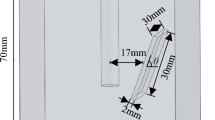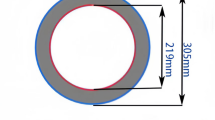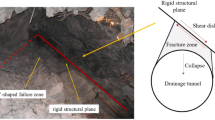Abstract
Block-flexure is the commonest mode of toppling failure and can be frequently encountered in anti-inclined rock slopes. In this work, the failure mechanism of block–flexure toppling (BFT) was investigated using centrifugal and numerical models. The numerical model was configured using the Universal Distinct Element Code (UDEC) and calibrated with the results of the centrifuge test. All the simulation results, including the measured displacements, failure load, and failure surface, are generally in line with that of experimental results. Further, the results of simulations show that, well before the appearance of instability in the jointed rock slope, slipping failure and opening fractures had occurred in the interlayer. Moreover, all the acting points of normal forces in steep joints are located between the bottoms and the midpoints of the columns under consideration, in the process of toppling failure. Finally, sensitivity of joint parameters, including the connectivity rate of discontinuous cross-joints, the thickness of the rock column joint, joint friction angle, and joint cohesion, were performed to investigate the effects of the tensile strength of intact rock. The results indicate that joint cohesion and thickness of the rock column greatly influence the failure load (represents safety factor of the slope). The connectivity rates of the discontinuous cross-joints and joint friction angle were found to have significant effects on the shape and location of the basal failure plane. This research would provide a deep understanding on the failure mechanism of BFT for relevant scholars.

modified from Goodman and Bray 1976)






















Similar content being viewed by others
References
Adhikary DP, Dyskin AV, Jewell RJ, Stewart DP (1997) A study of the mechanism of flexural toppling failure of rock slopes. Rock Mech Rock Eng 30(2):75–93
Adhikary DP, Dyskin AV (2007) Modelling of progressive and instantaneous failures of foliated rock slopes. Rock Mech Rock Eng 40(4):349–362
Alejano LR, Alonso E (2005) Application of the shear and tensile strength reduction technique to obtain factors of safety of toppling and footwall rock slopes. Impact of Human Act Geol Environ 7–13
Alejano LR, Iván GM, Roberto MA (2010) Analysis of a complex toppling-circular slope failure. Eng Geo 114(1):93–104
Alzo’ubi AK, Martin CD, Cruden DM (2010) Influence of tensile strength on toppling failure in centrifuge tests. Int J Rock Mech Min 47(6):974–982
Amini M, Gholamzadeh M, Khosravi H (2015) Physical and theoretical modeling of rock slopes against block-flexure toppling failure. Int J Min Geol Eng 49:155–171
Amini M, Majdi A, Veshadi MA (2012) Stability analysis of rock slopes against block-flexure toppling failure. Rock Mech Rock Eng 45(4):519–532
Aydan Ö, Kawamoto T (1992) The stability of slopes and underground openings against flexural toppling and their stabilisation. Rock Mech Rock Eng 25(3):143–165
Aydan Ö, Shimizu Y, Ichikawa Y (1989) The effective failure modes and stability of slopes in rock mass with two discontinuity sets. Rock Mech Rock Eng 22(3):163–188
Barla G, Borri-Brunetto M, Devin P, Zaninetti A (1995) Validation of a distinct element model for toppling rock slopes. 8th ISRM Congress. International Society for Rock Mechanics and Rock Engineering, Tokyo. Japan, pp 417–421
Chen GQ, Chen T, Chen Y, Huang R, Liu M (2018) A new method of predicting the prestress variations in anchored cables with excavation unloading destruction. Eng Geo 241:109–120
Chen ZY, Gong WJ, Ma GW, Wang J, He L, Xing YC, Xing JY (2015) Comparisons between centrifuge and numerical modeling results for slope toppling failure. Sci China Technol Sc 58(9):1497–1508
Goodman RE, Bray JW (1976) Toppling of Rock Slopes. Proc., ASCE, Specialty Conf. on Rock Engineering for Foundations and Slopes. ASCE, Boulder Colorado 201–234
Gu DM, Huang D (2016) A complex rock topple-rock slide failure of an anaclinal rock slope in the Wu Gorge, Yangtze River, China. Eng Geo 208:165–180
He L, Tian Q, Zhao ZY, Zhao XB, Zhang QB, Zhao J (2018) Rock slope stability and stabilization analysis using the coupled DDA and FEM method: NDDA Approach. Int J Geomech 18(6):04018044
Hodder MS, White DJ, Cassidy MJ (2010) Analysis of soil strength degradation during episodes of cyclic loading, illustrated by the T-Bar penetration test. Int J Geomech 10(10):117–123
Itasca Consulting Group Inc (2011) UDEC (universal distinct element code), Version 4.0, Minneapolis
Lian JJ, Li Q, Deng XF, Zhao GF, Chen ZY (2017) A numerical study on toppling failure of a jointed rock slope by using the Distinct Lattice Spring model. Rock Mech Rock Eng 3:1–18
Lin ML, Wang KL (2006) Seismic slope behavior in a large-scale shaking table model test. Eng Geo 86(2):118–133
Liu CH, Jaksa MB, Meyers AG (2009) A transfer coefficient method for rock slope toppling (EI). Can Geotech J 46(1):1–9
Liu F, Zhao J (2013) Limit analysis of slope stability by rigid finite element method and linear programming considering rotational failure. Int J Geomech 13(6):827–839
Mohammadi S, Taiebat H (2015) H-adaptive updated Lagrangian approach for large-deformation analysis of slope failure. Int J Geomech 15(6):04014092
Moo-Yong H, Myers T, Tardy B, Ledbetter R, Vanadit-Ellis W (2003) Centrifuge simulation of the consolidation characteristics of capped marine sediment beds. Eng Geo 70(3):249–258
Muller L (1968) New considerations on the Vaiont slide. Rock Mech Eng Geo 6(1):1–91
Wyllie DC (1980) Toppling rock slope failures examples of analysis and stabilization. Rock Mech 13(2):89–98
Wyllie DC, Mah C (2004) Rock slope engineering, Fourth Edition, 4th edn. Spon Press, London
Yang YT, Xu DD, Zheng H (2018) Explicit discontinuous deformation analysis method with lumped mass matrix for highly discrete block system. Int J Geomech 18(9):04018098
Zhang JH, Chen ZY, Wang XG (2007) Centrifuge modeling of rock slopes susceptible to block toppling. Rock Mech Rock Eng 40(4):363–382. https://doi.org/10.1007/s00603-006-0112-9
Zhang HN, Chen CX, Zheng Y, Yu QQ, Zhang W (2020) Centrifuge modeling of layered rock slopes susceptible to block-flexure toppling failure. Bull Eng Geol Environ 79:3815–3831
Zhao L, Wang J, An LL, Wang L, Xiang, Liang RY (2015) A case study integrating numerical simulation and GB-InSAR monitoring to analyze flexural toppling of an anti-dip slope in Fushun open pit. Eng Geol 197:20–32
Zheng Y, Chen C, Liu T, Ren Z (2021) A new method of assessing the stability of anti-dip bedding rock slopes subjected to earthquake. Bull Eng Geol Environ 80:3693–3710
Zheng Y, Chen CX, Liu TT, Song DR, Meng F (2019) Stability analysis of anti-dip bedding rock slopes locally reinforced by rock bolts. Eng Geol 251:228–240
Zheng Y, Chen CX, Liu TT, Xia KZ, Liu XM (2017) Stability analysis of rock slopes against sliding or flexural-toppling failure. Bull Eng Geol Environ 77(4):1383–1403
Zheng Y, Chen CX, Liu TT, Zhang HN, Xia KZ, Feng L (2018) Study on the mechanisms of flexural toppling failure in anti-inclined rock slopes using numerical and limit equilibrium models. Eng Geo 237:116–128
Zheng Y, Chen CX, Meng F, Zhang HN, Xia KZ (2020a) Assessing the stability of rock slopes with respect to block-flexure toppling failure using a force-transfer model and genetic algorithm. Rock Mech Rock Eng 53:3433–3445
Zheng Y, Chen CX, Meng F, Liu TT, Xia KZ (2020b) Assessing the stability of rock slopes with respect to flexural toppling failure using a limit equilibrium model and genetic algorithm. Comput Geotech 124:103619
Funding
This research was financially supported by the National Natural Science Foundation of China (Grant Nos. 12072358 and 11472293), the Science and Technology Research Project of Education Department of Jiangxi Province (Grant No. GJJ200661) and the Natural Science Foundation of Jiangxi, China (Grant No. 20202BABL214051), the Open Research Fund of State Key Laboratory of Geomechanics and Geotechnical Engineering, Institute of Rock and Soil Mechanics, Chinese Academy of Sciences (Grant NO. Z020021).
Author information
Authors and Affiliations
Corresponding author
Rights and permissions
About this article
Cite this article
Zhang, H., Xu, X., Zheng, Y. et al. Experimental and numerical study of the mechanism of block–flexure toppling failure in rock slopes. Bull Eng Geol Environ 81, 63 (2022). https://doi.org/10.1007/s10064-021-02562-2
Received:
Accepted:
Published:
DOI: https://doi.org/10.1007/s10064-021-02562-2




